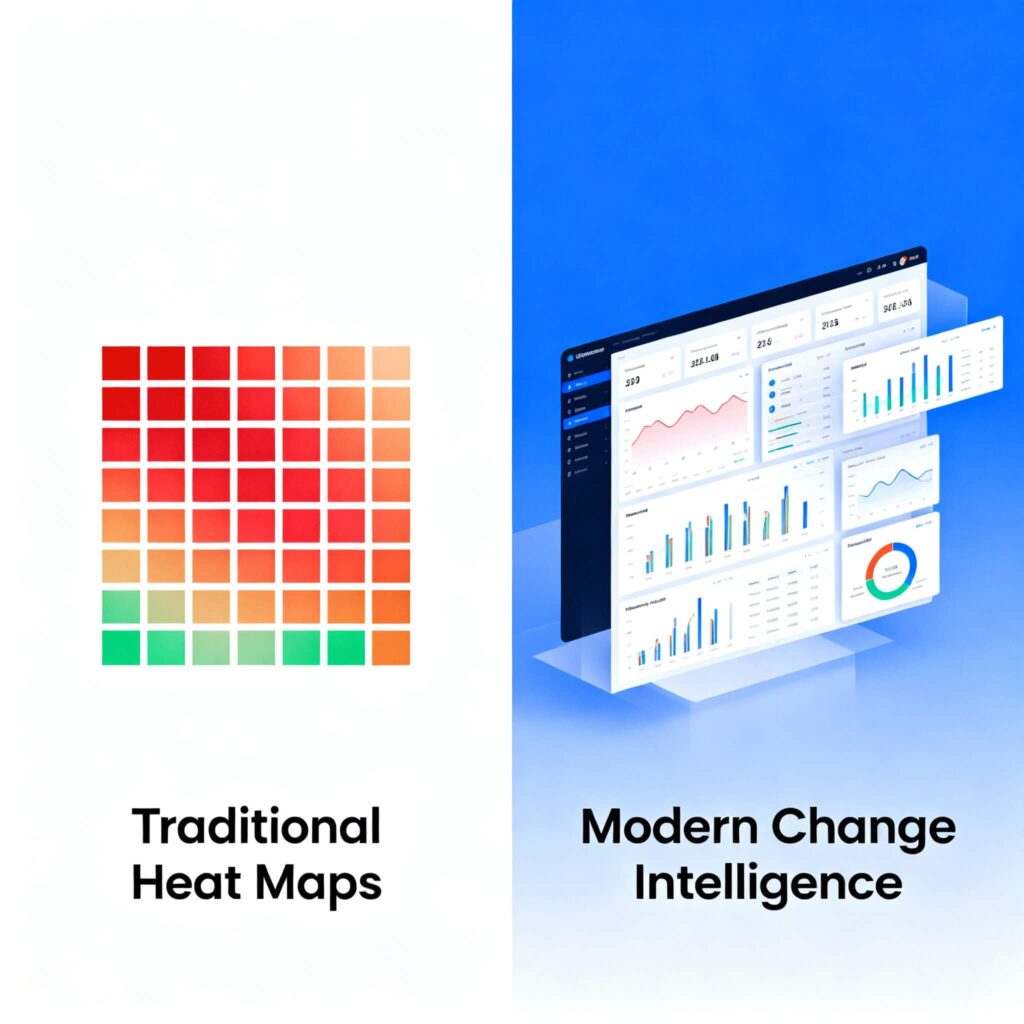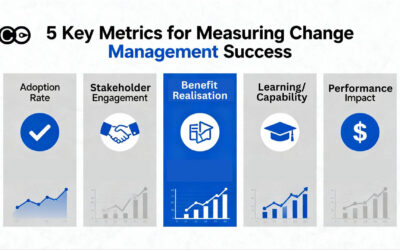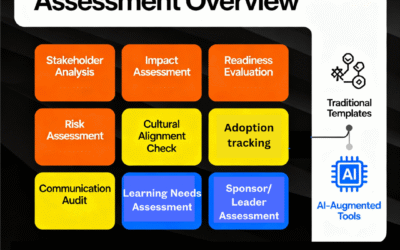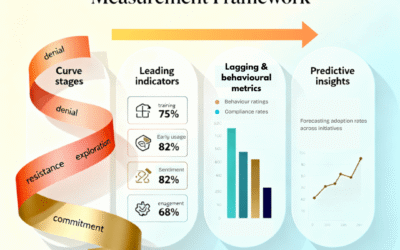Change impact assessment has become a cornerstone of effective change management, providing practitioners with visual tools to understand and communicate how organisational transformations will affect different areas of the business. The change management heat map, with its familiar red, amber, and green colour coding, has emerged as one of the most widely used change management tools and techniques for visualising change impact across departments, teams, and business units.
For change managers beginning their impact assessment journey, heat maps offer an accessible entry point into systematic change analysis. They provide a visual framework that executives can quickly grasp and a structured change management approach for gathering stakeholder input about change effects across the organisation. Understanding how to manage change through these tools effectively remains an important foundational skill for change management professionals pursuing change management best practices.
We will explore a comprehensive approach to creating change management heat maps, from initial setup through stakeholder engagement and final presentation. However, we will also explore the significant limitations of traditional heat map approaches and examines why modern organisations require more sophisticated change assessment tools to successfully navigate complex change initiatives.
Understanding change management heat maps
What is a change management heat map
A change management heat map is a visual representation that displays the anticipated impact of change in organisations across different areas of the business using colour-coded matrices. Most commonly, these maps use traffic light colours – red for high impact, amber for medium impact, and green for low impact – to provide stakeholders with an immediate visual understanding of where change will be most significant within their change management framework.
Heat maps typically organise information along two key dimensions as part of a structured change management methodology. The vertical axis usually represents different organisational areas (departments, business units, locations, or roles), while the horizontal axis might show different types of change impact (process changes, technology changes, people changes, structural changes) or different phases of the change initiative (planning, implementation, adoption, sustainment). There are also other display methods including months of the year at the horizontal axis and business process changes along the vertical axis.
The appeal of heat maps lies in their simplicity and visual impact for implementing change management. Executives can quickly scan the map to understand which areas require the most attention and resources, while change managers can use the visual to guide conversation about support needs and intervention strategies as part of their change management activities.
When heat maps are most useful
Heat maps work particularly well in several specific contexts within the change management process:
• Initial change scoping: When you need to provide stakeholders with a high-level overview of change impact across the organisation during early change management planning
• Executive communication: When presenting to change leadership who require rapid visual understanding of impact distribution
• Resource planning: When making initial decisions about where to focus change management resources and effort
• Stakeholder engagement: When facilitating discussions with business unit leaders about their areas’ change requirements
Heat maps also serve as effective starting points for more detailed change analysis. They can help identify areas that warrant deeper investigation and provide a change management framework for structuring stakeholder conversations about specific impacts and needs.
Creating your change management heat map: a step-by-step guide
Step 1: Define your assessment scope and dimensions
Before creating your heat map, you need to establish clear parameters for your analysis as part of fundamentals of change management. This foundational step determines the effectiveness and usefulness of your final change assessment.
Identifying organisational areas for assessment: Start by determining which parts of the organisation your change initiative will affect. Common approaches to managing organizational change include:
• Departmental breakdown (Finance, Marketing, Operations, HR)
• Business unit analysis (Product divisions, geographic regions, customer segments)
• Functional role groupings (Front-line staff, middle management, senior leadership)
• Location-based divisions (Head office, regional offices, field locations)
Selecting impact dimensions: Choose the types of change impact you want to assess using proven change management techniques. Typical dimensions include:
• Process changes (new workflows, revised procedures, updated standards)
• Technology changes (new systems, software upgrades, digital tools)
• People changes (role modifications, skill requirements, reporting relationships)
• Cultural changes (values, behaviours, communication patterns)
• Structural changes (organisational design, governance, decision-making authority)
Establishing your rating scale: Define what constitutes different levels of change in your organisational context:
• High impact (Red): Significant changes requiring extensive support, training, or adjustment
• Medium impact (Amber): Moderate changes requiring some support and adjustment
• Low impact (Green): Minor changes requiring minimal support or adjustment
Document these definitions clearly as part of your change management plan, as they’ll guide all subsequent change management activities and ensure consistency across different evaluators.
Also note that change heatmaps can be focused for one specific project, or multiple projects within a portfolio, a department or across the whole organisation.
Step 2: Gather stakeholder input and data
Effective heat map creation requires systematic data collection from relevant stakeholders who understand the operational realities of different organisational areas, representing core change management principles of stakeholder engagement.
Identifying key informants: Select stakeholders who can provide accurate insights about change impacts for your change management process:
• Business unit leaders who understand operational requirements
• Subject matter experts familiar with current processes and systems
• Front-line managers who understand day-to-day work realities
• HR representatives who understand people and capability implications
• Technical specialists who understand system and process dependencies
Conducting impact assessment interviews: Structure your stakeholder conversations to gather consistent, comparable information and conduct subsequent analysis given the organisation environment:
• Present the change initiative overview and timeline
• Explain your impact assessment dimensions and rating scale
• Walk through each relevant organisational area
• For each area, discuss the nature and extent of changes across your chosen dimensions
• Document not just the ratings but the reasoning behind them
• Identify any dependencies or interconnections between areas
Using assessment surveys and workshops: Complement interviews with broader data collection methods as part of comprehensive change management techniques:
• Change management surveys for stakeholders who can’t participate in detailed interviews
• Group workshops to explore areas where multiple perspectives are valuable
• Focus groups to understand specific stakeholder concerns and requirements
• Document reviews to understand current state processes and procedures
Step 3: Build your heat map matrix
With your data collected, you can begin constructing your visual heat map representation using appropriate change management tools and techniques.
Setting up your matrix structure: Create a grid with your organisational areas on one axis and your impact dimensions on the other. Most practitioners use spreadsheet for this initial construction, though purpose-built change assessment tools offer additional functionality.
Populating impact ratings: For each intersection of organisational area and impact dimension within your change management framework:
• Review your stakeholder input and supporting data
• Apply your defined rating criteria consistently
• Assign the appropriate colour code (red, amber, green)
• Document the rationale for each rating in supporting notes
Adding supporting information: Enhance your heat map with additional context following change management best practices:
• Include brief descriptions of the specific changes driving each rating
• Note key dependencies or risks associated with high-impact areas
• Identify stakeholder groups requiring particular attention
• Document assumptions and data sources for transparency
Creating visual clarity: Ensure your heat map is visually effective for change management communication:
• Use consistent colour schemes and formatting
• Include clear legends explaining your rating system
• Add titles and labels that make the map self-explanatory
• Consider using different visual elements (patterns, symbols) to convey additional information
Step 4: Validate and refine your assessment
Before finalising your heat map, validate your analysis through stakeholder review and refinement as part of rigorous change management methodology.
Stakeholder validation sessions: Present your draft heat map to key stakeholders for feedback on your change assessment:
• Walk through your methodology and rating criteria
• Review specific ratings for areas where stakeholders have expertise
• Explore any unexpected patterns or outliers in your assessment
• Gather additional context or information that might affect your ratings
Cross-referencing and consistency checking: Review your heat map for internal consistency within your change management approach:
• Compare similar organisational areas to ensure rating consistency
• Check that interdependent areas have appropriate ratings
• Verify that your impact assessment aligns with known change requirements
• Ensure your ratings reflect the actual scope and timeline of planned changes
Incorporating feedback and adjustments: Refine your heat map based on stakeholder input following change management principles:
• Adjust ratings where new information suggests different impact levels
• Add missing organisational areas or impact dimensions
• Clarify definitions or criteria where confusion arose
• Document changes and the reasoning behind them
Step 5: Present and utilise your heat map
The final step involves presenting your heat map effectively and using it to guide change management planning for change success.
Executive presentation strategies: When presenting to change leadership:
• Start with an overview of your methodology and data sources
• Highlight the highest-impact areas requiring immediate attention
• Explain the implications for resource allocation and timeline
• Connect impact patterns to business priorities and strategic objectives
• Provide clear recommendations for next steps in your change management plan
Facilitating stakeholder discussions: Use your heat map as a conversation starter for managing change:
• Focus discussions on high-impact areas and required support
• Explore dependencies and interconnections between areas
• Identify opportunities for shared resources or coordinated approaches
• Develop action plans for addressing specific impact requirements
Translating insights into change strategy: Convert your heat map findings into practical change management plans:
• Prioritise high-impact areas for early engagement and support
• Design targeted interventions based on specific impact types
• Allocate change management resources according to impact intensity
• Develop communication messages tailored to different impact levels
• Create change monitoring approaches to track progress in critical areas

The growing limitations of traditional heat map approaches
While heat maps serve as useful introductory tools for change assessment, experienced change managers increasingly recognise their significant limitations in complex organisational environments. These limitations become particularly problematic when dealing with large-scale transformations, multi-dimensional changes, or sophisticated organisational structures that require advanced change management analytics.
Risks in using the heatmap
A lot of change managers have experienced situations where they walk into a leadership meeting expecting to have discussions about business areas most impacted by the change, and instead:
- They are interrogated about how the colours are determined and are asked to justify how logical the ratings are
- Stakeholders’ eyes glaze over the visuals since there is not much they could do with the information beyond a nice FYI
- Stakeholders start asking questions about specific decisions required for business capacity risks, but decisions are hard to make with high level categorical ratings that does not allow any depth in drilling down to specific details
The psychological bias challenge
The most immediate problem with heat maps lies in their reliance on traffic light colours that carry inherent psychological associations. When stakeholders see red, they instinctively interpret this as “bad” or “problematic,” while green suggests “good” or “safe.” Yet in change impact assessment, these colours are supposed to represent intensity of change, not positive or negative outcomes.
This psychological bias creates several practical change management challenges that undermine the effectiveness of heat map communication. A department marked as “red” for high change impact might be perceived as where the attention should be. However, it may be that the department has great leadership strength and team capability and the changes for them are not more significant than for other departments that are less change-mature. Conversely, “green” areas might be overlooked entirely, even if they contain critical dependencies or risks that need change monitoring.
More problematically, this colour-coding system makes it remarkably easy for stakeholders to challenge your assessments. “Why is marketing red when they’re already using digital tools?” or “How can finance be amber when they’ve been through system changes before?” These questions expose the fundamental issue: heat maps don’t provide the underlying logic, criteria, or evidence base that supports the colour assignments, limiting their effectiveness as change management validity tools.
The decision-making limitation crisis
Perhaps the most damaging limitation of heat maps is their inability to support actual decision-making within enterprise change management. While they might look impressive in executive presentations, they provide no actionable intelligence about what needs to be done differently. A department coded as “high impact” tells you nothing about:
• What specific interventions are required
• When those interventions should be deployed
• What resources are needed for successful implementation
• How this area’s change journey interconnects with others
• What success looks like for this particular context
This lack of actionable insight means that heat maps often become wallpaper real estate – visually appealing but functionally useless for the practical work of managing change through complex initiatives.
The granularity gap that undermines effectiveness
Traditional heat maps operate at the department or business unit level, but modern change rarely respects these organisational boundaries. Consider a digital transformation affecting customer service operations. Within a single “customer service department,” you might have:
• Front-line staff handling phone enquiries (high process change, moderate technology change)
• Digital chat specialists (low process change, high technology change)
• Team leaders managing hybrid teams (high people change, moderate process change)
• Quality assurance analysts (moderate process change, high reporting change)
• Training coordinators (high content change, moderate delivery change)
A single colour coding for this department obscures these critical differences, making it impossible to design targeted interventions that address specific needs within your change management methodology.
The granularity problem extends beyond roles to encompass geographic, temporal, and contextual variations. Teams in Melbourne might experience different impacts than those in Brisbane due to local market conditions. Day shift workers might face different challenges than evening shift staff. Customer-facing roles require different support than back-office functions.
Why Excel-based approaches are obsolete in 2025
The credibility challenge of 1980s methodology
Using Excel spreadsheets for change impact assessment in 2025 is equivalent to bringing a slide rule to a data science conference. It signals to stakeholders – particularly senior executives and technology-savvy employees – that your change management approach is fundamentally outdated.
This isn’t about being fashionable with technology; it’s about organisational credibility in change management in business. When your finance team is using sophisticated analytics platforms to forecast revenue, your marketing team is leveraging AI-powered customer insights, and your operations team is using real-time dashboards to monitor performance, presenting change analysis in basic Excel spreadsheets undermines confidence in your entire change management approach.
The credibility problem extends to practical limitations as well. Excel-based approaches typically can’t handle complex stakeholder relationships and dependencies, provide real-time collaboration capabilities for distributed teams, generate automated insights from pattern recognition, integrate with other organisational data sources, support sophisticated filtering and drill-down analysis, or scale effectively across large organisations requiring enterprise change management capabilities.
The mathematical inconsistency problem
From a purely analytical perspective, heat maps violate fundamental principles of data representation. They attempt to multiply likelihood values by impact scores to determine “heat,” but this mathematical operation is meaningless when you’re combining different types of data.
Likelihood is typically represented as a bounded integer (1-5), but impact is represented as an ordinal value. Ordinal values tell you about sequence or ranking, but they don’t tell you about the mathematical distance between categories. An impact of “3” doesn’t communicate how much more severe it is than a “2” or how much less severe than a “5.” Yet the heat map calculation treats these as if they were proper numbers that can be multiplied together.
This mathematical inconsistency undermines any attempt to use heat map results for prioritisation or resource allocation decisions within your change management framework. You can’t meaningfully compare a “9” heat score from one area with a “6” from another when the underlying calculation is mathematically invalid.
The modern requirements for sophisticated change impact understanding
Multi-dimensional analysis capabilities
Contemporary change impact assessment must move beyond simple high-medium-low categorisations to support multi-dimensional analysis that enables measuring change management effectiveness. This means simultaneously examining impacts across temporal dimensions (when do impacts occur?), stakeholder dimensions (how do impacts vary by role, location, team?), impact type dimensions (process, technology, cultural, structural changes?), severity dimensions (magnitude of change required?), and readiness dimensions (change readiness levels of different groups?).
This multi-dimensional approach enables change managers to identify patterns and relationships that aren’t visible in simplified heat map representations. It supports strategic decision-making at multiple organisational levels through location-based analysis of regional variations, role-based analysis of specific competency requirements, team-based analysis of group dynamics, and activity type analysis of operational requirements for successful change management.
Real-time collaboration and predictive capabilities
Sophisticated change impact assessment requires platforms that support real-time collaboration, dynamic updating as change initiatives evolve, and predictive analytics to identify risks and opportunities that might not be obvious to human analysts. This represents a fundamental shift in change management tools and techniques.
This includes automated notifications, integration with project management tools, pattern recognition across similar historical initiatives, predictive modelling of adoption rates, and resource optimisation recommendations based on impact patterns. These capabilities enable change management tracking and monitoring change management effectiveness in real-time rather than through static reports.
Advanced metrics and dashboards
Modern change impact assessment platforms can provide sophisticated change management metrics dashboards that go beyond simple traffic light indicators. This includes change management performance metrics that track adoption rates, resistance levels, competency development, and behavioural change indicators across multiple dimensions.
These platforms should support change management success metrics such as time-to-proficiency, intervention effectiveness rates, stakeholder satisfaction levels, and business outcome achievement. The ability to measure change management success through granular data analysis represents a critical advancement over traditional heat map approaches.
To find out more about leveraging change management platforms check out The Change Compass.

Building organisational intelligence beyond artefacts
From assessment tools to strategic capability
The most significant limitation of traditional heat maps isn’t their visual representation – it’s their treatment of change impact assessment as an artefact rather than a capability. Heat maps encourage organisations to think of impact assessment as something you create, present, and file away, rather than as an ongoing intelligence system that informs decision-making throughout the change cycle.
Building sophisticated change assessment capability requires organisations to invest in systematic data collection processes, analytical expertise and tools, decision-making integration, and continuous improvement mechanisms. This represents a fundamental shift from traditional change management approaches to agile change management methodologies that adapt based on real-time intelligence, inline with how other business functions are digitising.
Developing competitive advantage through assessment sophistication
Organisations that develop sophisticated change impact assessment capabilities gain significant competitive advantages in their transformation initiatives. These advantages include faster implementation cycles, higher adoption rates, reduced resistance and conflict, better resource allocation, improved stakeholder confidence, and enhanced learning organisation capabilities.
The future of change management platforms that combine human insight with analytical power, providing change managers with intelligence for informed decisions about complex transformations. This includes artificial intelligence capabilities, predictive analytics, and collaborative capabilities that harness collective organisational knowledge for change management success. And luckily, a lot of these capabilities are already available.
Strategic implementation for modern organisations
For organisations ready to move beyond traditional heat maps, the transition should be strategic and systematic rather than sudden. This involves augmenting existing approaches while building more sophisticated analysis underneath, implementing collaborative platforms that support real-time change management tracking, and building predictive capabilities that model different change management scenarios.
The organisations that master this integrated approach to change impact assessment will find themselves better equipped to handle the accelerating pace of change while maintaining focus on the human experience that ultimately determines change management success or failure. Change impact assessment work isn’t just about assessment – it’s about building the intelligence and adaptability that enables sustainable transformation through effective managing change practices in modern digital organisations.
The choice facing change managers is straightforward: continue relying on tools that provide the illusion of insight while undermining transformation success, or invest in sophisticated assessment capabilities that provide genuine intelligence for complex change initiatives. The red, amber, and green squares have served their purpose, but the future belongs to organisations that can measure change management effectiveness through meaningful, real-time intelligence that drives superior change management outcomes.
Frequently Asked Questions
Q: When should I still use heat maps instead of more sophisticated assessment tools?
A: Heat maps remain appropriate for simple changes, initial scoping exercises where you need quick visual communication to executives, organisations with limited change management maturity just beginning systematic impact assessment, and simple changes with clear, departmental boundaries. However, even in these situations, consider heat maps as a starting point rather than a complete assessment solution. For complex change environments, a heatmap may be an initial view, to be supplemented by other visuals.
Q: How do I measure the effectiveness of my new change impact assessment approach?
A: Establish baseline change management success metrics before implementing new approaches, then track improvements in key areas including change initiative success rates, time-to-adoption for new processes, stakeholder satisfaction with change support, accuracy of impact predictions versus actual outcomes, adoption outcome, and early identification of risks and issues. Compare these metrics against historical heat map-based assessments.
Q: What are the main risks of moving beyond heat maps, and how do I mitigate them?
A: Primary risks include increased complexity overwhelming stakeholders (mitigate through phased implementation and training), higher initial costs (justify through business case and ROI projections), resistance to new approaches, and over-analysis leading to paralysis (establish clear decision-making frameworks and timelines). Start with pilot implementations to demonstrate value before organisation-wide rollout.
Q: How do I maintain stakeholder engagement when moving to more comprehensive assessment processes?
A: Maintain engagement by clearly communicating the benefits of better decision-making, providing simplified executive summaries alongside detailed analysis, using interactive dashboards and visualisations that make complex data accessible, involving stakeholders in defining assessment criteria and success measures, and demonstrating quick wins through improved change outcomes. Focus on how sophisticated assessment leads to more targeted, efficient interventions that reduce disruption for end users.






